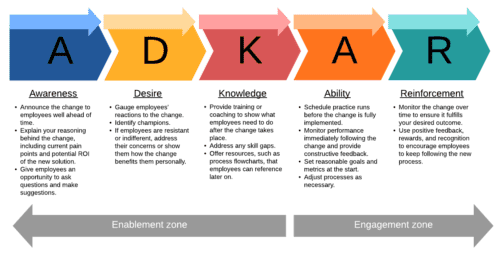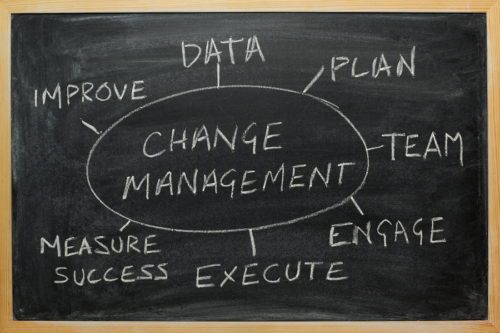Why and how should I utilize Organizational Change Models?
You engaged in a current state assessment, you designed the ideal future state, you picked the right software, now how do you make all these changes stick successfully? This question is key in ensuring the success of your processes improvement efforts and can be solved through the use of some organizational change management models.
After investing heavily in time, money, and resources, perhaps in a lean improvement project, you want to start recognizing the return on your investment as quickly and fully as possible. Luckily, throughout our process improvement engagement, we planned for organizational change management. And while the approach may have varied slightly, our foundation is anchored in some strong organizational change models, namely Kotter’s Theory and ADKAR. Both add great value, one is focused on detailed steps to ensure the message is communicated and adopted, the other is focused on the success of the change at the individual level to move the change at the macro level.
We’ll explore some strengths of these models below as well as look at where they fit within our process improvement methodology. This exploration will give you some tangible ideas to take back and put into practice during your own change management. At a high level, elements of these models provide a sort of checklist for your organizational change management planning. Your plan should include:
- Create and share a vision
- Create momentum for change
- Develop, grow, and sustain the momentum
- Maintain the results of the change
Let’s take a look at some highlights, strengths, and weaknesses of each…
Kotter’s Theory Highlights
Kotter’s theory is an 8-step process developed over a long period of time by Dr. Kotter and is based on his observations. He developed these observations from his evaluation of 100 organizations engaged in a process of change. Simply put, when he saw the success he identified the factors that lead to it and created a methodology. This model provides a step by step, focused approach ensuring there is buy-in from the team, organization, subject matter experts, and stakeholders.
The 8 steps of this methodology are:
- Create a sense of urgency
- In order for change to stick, you need excitement. Create this excitement by evaluating and sharing the benefits as well as the need for the change.
- Build a guiding coalition
- Now that you’ve identified the message, you need messengers and allies. These are trusted, enthusiastic, champions of your organization. Utilizing team members that others admire will improve the chances of message acceptance.
- Form a strategic vision and initiatives
- Often, this comes from the top down with input from stakeholders and subject matter experts across the organization. Developing this vision as a collaborative effort will ensure direction while promoting buy-in.
- Enlist a volunteer army
- Massive, impactful change is like rowing a Viking ship. It takes an army, working together, pulling hard (especially at first) to get the ship moving. You’ll need to develop a movement through your message and use your coalition to get everyone else on board. Address the concerns of those who are slow to join to facilitate their willing involvement.
- Enable action by removing barriers
- If you empower and excite your organization but don’t allow them to take action or participate you’ll have committed a grave mistake. These barriers could be restrictions on creativity or slow and inefficient processes. Either way, their removal is a must.
- Generate short-term wins
- Identify low hanging fruit or opportunities for immediate improvement that will get the ship of change moving. These will encourage momentum and further buy-in from the group.
- Sustain accelerations
- You got it off the ground, no keep it going! Regular check-ins, evaluations, and adjustments are a must. Do everything possible to continue the change without moving backward or stopping. It’s hard to get moving again.
- Institute change
- Reinforce your message and make sure the change is the long term by showing how the urgency and buy-in accomplished the goals of change. How is everyone’s life easier, did the organization improve, and how are you positioned to succeed in the future?
Kotter’s Theory Strengths and Weaknesses
Kotter’s theory has some strengths and weaknesses as a model. It is founded in enormous amounts of supporting information and observations. It is a clear guide to utilizing strengths within your organization to ensure your change is successful. And the step by step design makes it intuitive to follow.
However, the step by step nature may also create a shortcoming in its application. This does not provide for a quick process. While change takes time, execution of the step by step process may extend that time. Extensive planning and preparation must go into each step to ensure success and steps should be followed in sequential order. This limits the agility of the model and the ability to adjust quickly at any stage of the process.
ADKAR Highlights
The founder of a global leader in change management, Prosci, created the ADKAR organizational change model. Jeff Hiatt created his model to emphasize 5 outcomes needed to ensure change lasts and is successful. These outcomes function as goals that drive activities in the change management model. Each letter represents one of the pillars of the model. These pillars are all rooted in solid research. The overall theme of the ADKAR model is that true change only occurs when the individuals of the organization change.

The 5 outcomes of the ADKAR model are:
- Awareness of the need for change
- Inform your employees and stakeholders of the change and action, develop enthusiasm, and encourage input.
- Desire to support the change
- Creating awareness is just the start. You must develop the desire to support. Not having the support at the individual level will result in the failure of all other efforts.
- Knowledge of how to change
- Knowledge of the change goes beyond awareness. It’s not just knowing the what, but also the how. Inform the employees and stakeholders of how the change will occur and encourage input. Create the action plan out of this knowledge and enable the execution.
- Ability to demonstrate skills & behaviors
- There is a difference between knowing how and being able to execute the change. Gauge your employees’ ability to execute the proper actions of the change, identify any gaps, and provide support where needed.
- Reinforcement to make the change stick
- Ensure the change is stable at the ground and individual levels by implementing set defined processes and incentives to keep the change moving.
ADKAR Strengths and Weaknesses
This model also has its strengths and weaknesses. It is agile, flexible, and outcome-oriented. It allows for adjustment in-process and focuses on success at the individual level. Accordingly, that focus on the individual creates improved chances of success. It also clearly states desired outcomes, shifting the effort to designing the method to achieve those outcomes.
However, due to its stripped-down steps and focus on the individual level, ADKAR may not be applicable to large change management needs. The inputs are less defined and the model should be utilized only if the desired change is known and well defined.
How do these Organizational Change Models fit with TSI’s methodology?
As mentioned above, TSI weaves a combination of these models together with our transformation or software implementation methodology. In our methodology, we begin with an organizational context discussion. In short, this discussion forms a strategic vision through input from stakeholders and upper management, setting the basis for the design of the ideal future state.
Analysis of current state processes results in identifying the gaps in ability and knowledge. From there, a plan to fill those gaps is created and implemented, further enabling the change. The analysis also results in short term wins and removal of barriers, keys to both organizational change management models in that the reinforcement needed to ensure the change sticks is achieved.
Additionally, TSI encourages buy-in in the change process by involving those responsible for the workflows in the design of the future state processes. This practice helps share the vision, creates urgency, and builds both the army and the coalition.
Finally, our implementation planning and project management considers the best way to sustain, institute, and reinforce the change. Communication planning, continued sharing of the vision, addressing those with concerns about the change, training, badges, and incentives for participation, and evaluation of success are all key to the management of the project.
Organizational Change Model Takeaways

As we explored the strengths and weaknesses of each of the above models, you may still be thinking, “Which one should I use”. The answer, to quote my MBA finance professor, is “it depends.”
If your organization is agile and working on a smaller change initiative the flexibility of the ADKAR model may best fit your needs. It is outcome-oriented and its success thrives on adoption at the individual level to foster the change. However, it lacks the structure that may be needed for a larger organization or initiative.
Conversely, if you are embarking on a larger, more complicated change management effort then Kotter’s is the way to go. The step by step nature of the model lays out a clear path for ensuring success in the change efforts. For this reason, if time and resources are available, the foundation of Kotter’s method leads to the long term success of your efforts.
Of course, there’s always the hybrid approach, taking the key points from both and applying them to your situation. This is often the TSI approach, as highlighted earlier. Our highlights include:
- Start a movement by building a vision and involving stakeholders
- Grow the movement through empowerment and communication
- Sustain the movement through enablement, removing barriers, and enhancing the ability
- Maintain the results of the movement with reinforcement and short-term success as the changed becomes institutionalized
Organizational Change Models Wrap Up
This certainly doesn’t cover all of the change management models out there, but it highlights a few that we believe in and that we know help ensure that change sticks. This is especially true when the key portions work together with our proven methodology.
Finally, please take this information and share it with those who might be interested. Don’t forget to reach out to us to discuss more organizational change management, process improvement, and how they can be combined to grow and transform your organization.
